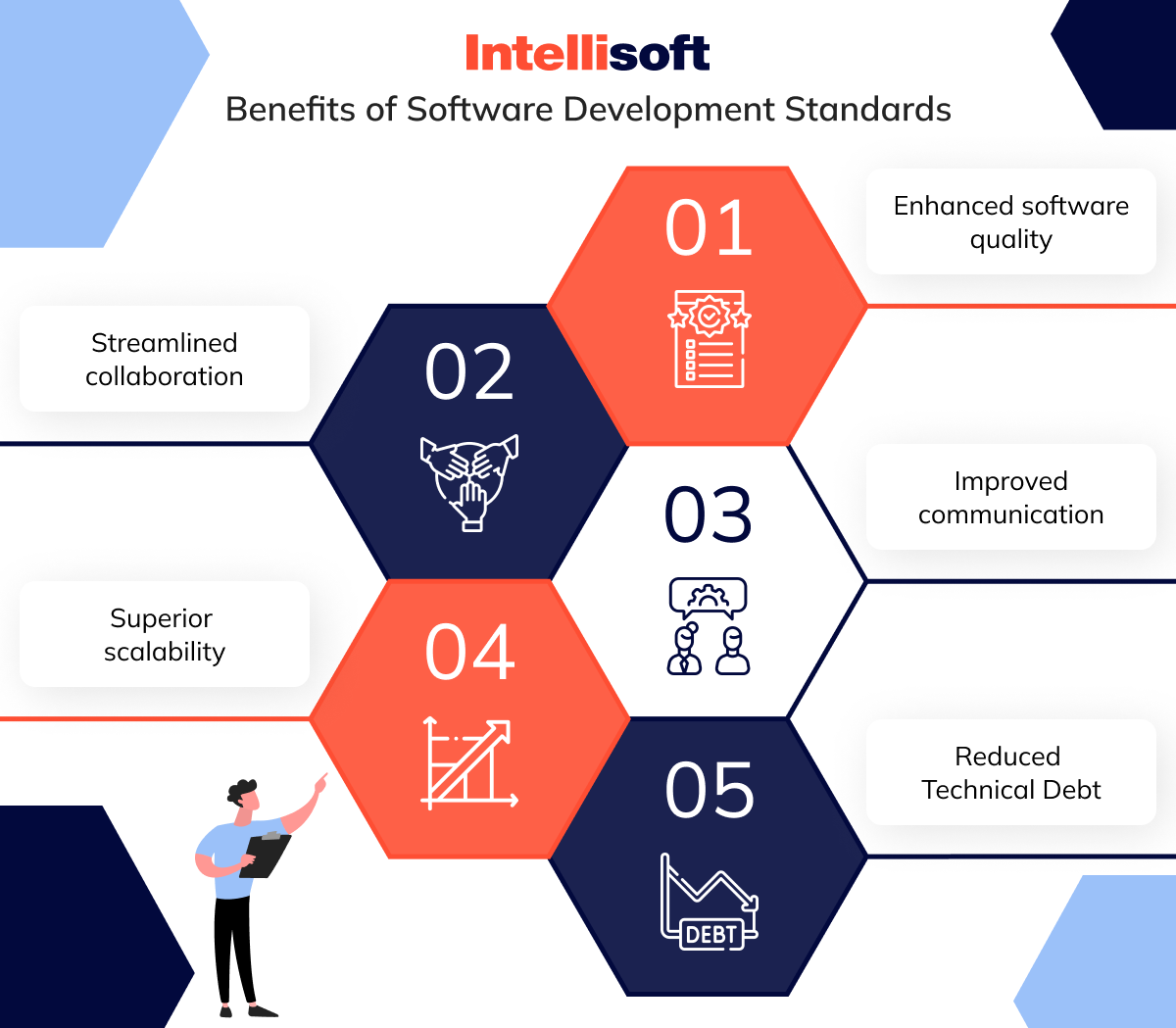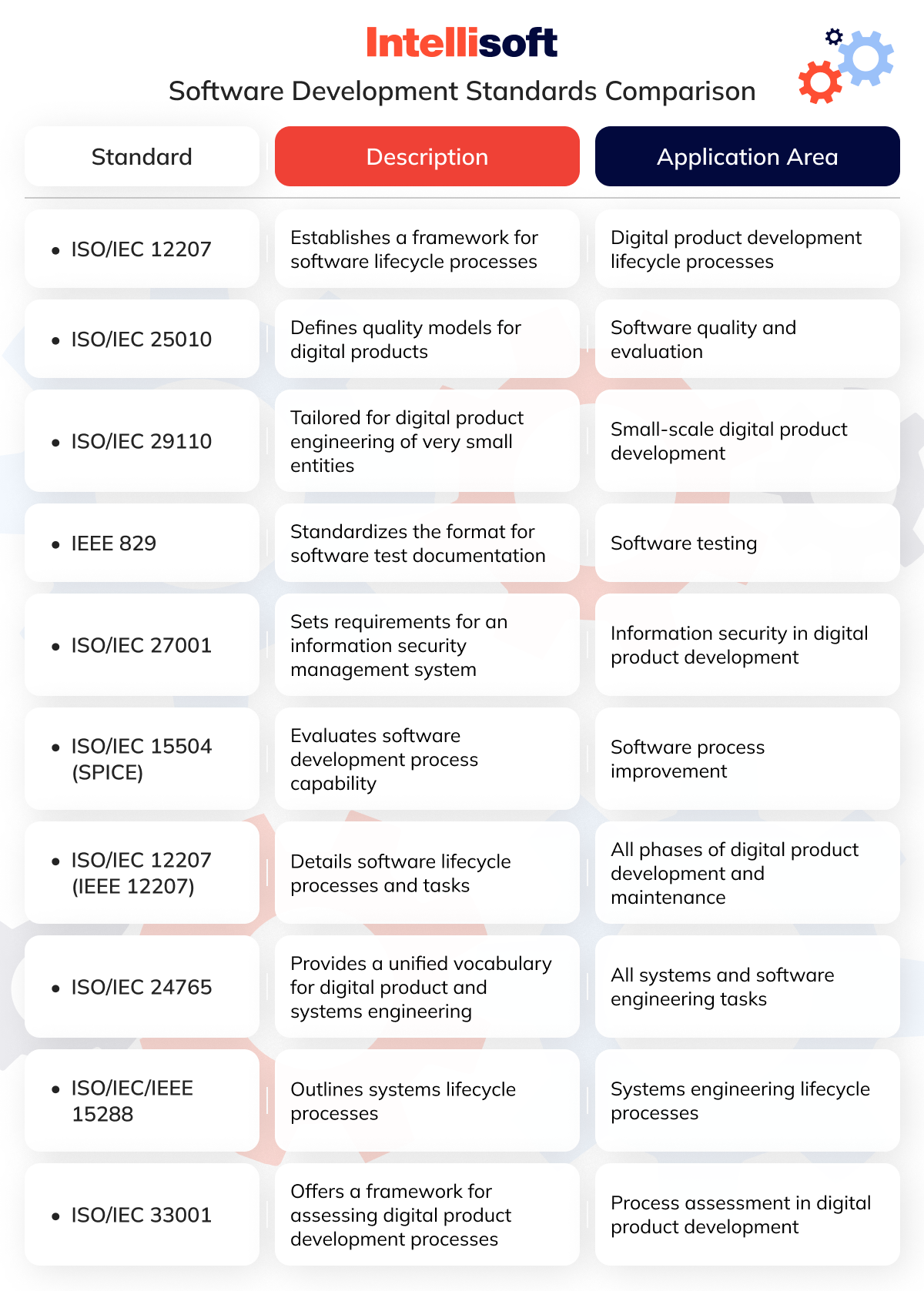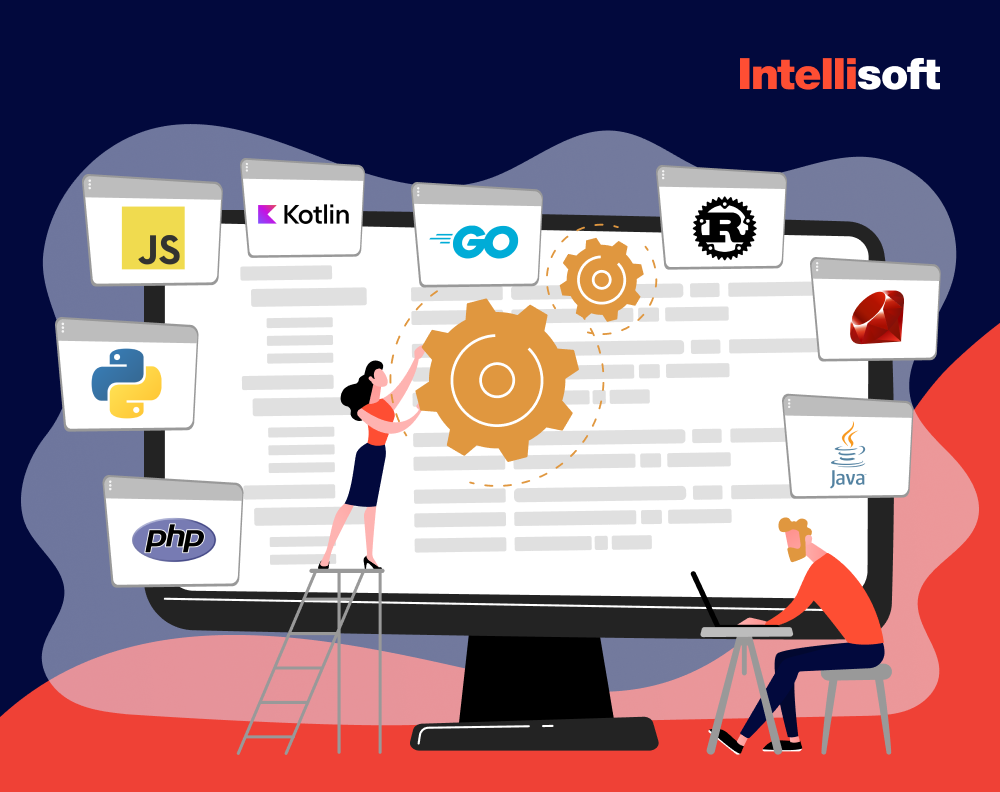Developers don’t conjure up programs from thin air; they navigate a complex framework of global rules, guidelines, and standards. Software development standards, set by influential bodies such as the ISO (International Organization for Standardization), IEEE (Institute of Electrical and Electronics Engineers), and IEC (International Electrotechnical Commission), guide the entire lifecycle of digital product development.
For development teams and their clients, whether outsourcing or managing projects in-house, understanding and following these standards is vital. Ignoring them can lead to hefty fines, damaged reputations, reduced customer satisfaction, and unwanted regulatory scrutiny. Therefore, staying informed and compliant is not just a best practice—it’s a crucial aspect of thriving in the digital age. Learn more about software development standards and best practices with this guide made by IntelliSoft experts.
Table of Contents
What Are Software Development Standards?
A software engineering standard is basically a playbook that spells out the specific rules and processes for developing digital products. Imagine it as the secret recipe a digital product development company uses to craft its software. These standards function like internal manuals, designed to guide only the company’s staff, making sure everyone is aligned and working in harmony when it comes to creating new software.
What Does Compliance with Software Development Standards Mean?
Navigating standard compliance often means dealing with extensive documentation, which might seem contrary to the agile philosophy’s preference for “working software over comprehensive documentation” [Fowler & Highsmith 2001; Agile Manifesto URL]. However, it’s important to recognize that the agile movement isn’t against all documentation—just the kind that doesn’t add real value to delivering high-quality digital products.
Agile methods are inherently adaptable, enabling them to meet software development standards and best practices when necessary. Despite this, a gap frequently exists in seamlessly integrating standard compliance processes within agile frameworks. This discussion examines principles from a review of ISO software standards in software engineering that could help bridge this gap.
In software engineering, ISO recommends starting with a quality manual. This manual acts as a blueprint for maintaining and enhancing the development life cycle, ensuring high customer satisfaction.
Next, it’s about implementing this quality manual into the development process. The Scrum framework often plays a key role here, involving the product owner, scrum master, and scrum team. These individuals are essential in bringing the documented processes to life.
ISO also advises establishing a structured hierarchy to improve the overall effectiveness of the process. Both ISO software development standards and Scrum stress the importance of continuous improvement, advocating a systematic approach to designing, executing, measuring, and refining processes, which is mirrored in Scrum’s cycle of sprint planning, execution, review, and retrospective.
Lastly, auditing is a crucial process where an independent entity evaluates the practices of the audited party and provides a formal assessment. This step is especially important in ensuring transparency and accountability, particularly in scenarios where activities are conducted independently or in private.
Why Do We Need Software Development Standards?
Software development process standards are crucial for producing high-quality, reliable, and secure digital products. Following these standards ensures that digital product not only meets but often surpasses customer expectations, aligning with global benchmarks. This dedication to quality enables businesses with certified developers to boost customer satisfaction, enhance their market reputation, and avoid costly compliance issues.
These standards provide clear guidelines and best practices for developers and teams. They facilitate successful project delivery, covering all aspects from development to implementation, distribution, security, and maintenance. By illuminating key areas of the software lifecycle, these standards help teams navigate the complex process of digital products creation effectively.

Code Formatting Guidelines
Excelling as a software developer requires mastering code formatting for optimal performance. Clear formatting guidelines not only make your code visually appealing but also improve readability, making it easier for you and your peers to identify individual functions and execution modules within the source code. By following best practices such as consistent naming conventions, proper indentation, well-spaced code snippets, and useful comments, you ensure your code is both functional and easy to maintain.
“The problem with quick and dirty, is that dirty remains long after quick has been forgotten.” — Steve McConnell
Security Procedures
Software development security standards are more than just a checklist of rules—they serve as your software’s primary shield against hackers and cyber threats. Imagine them as a comprehensive security system that prevents unwanted intrusions, ensuring your code remains robust and devoid of exploitable vulnerabilities. This approach extends beyond merely keeping up with the latest security updates and patches; it involves meticulously vetting inputs, spotting potential threats early on, and handling errors correctly. When errors are not managed securely, they can become prime targets for attackers. Therefore, secure coding is about crafting robust, resilient digital products capable of withstanding any digital assault.
Bug Discovery and Issue Resolution
Exceptional digital product should function without a hitch—it’s essentially part of its core duties. When a program stumbles or fails to meet expectations, it can alienate users, whether they’re team members counting on an internal system or customers engaging with your product. We’ve all experienced the irritation of an app crashing on our phones or a web platform acting up. Such issues not only frustrate users but can also deter potential clients and weaken current customer loyalty.
To address these problems, developers use advanced bug tracking and issue resolution tools. These tools, designed according to standards from top digital product development organizations, help detect and log bugs, prioritize them, and assign them to the right experts for fixing. Every step is carefully monitored to ensure that once a bug is fixed, it’s done thoroughly, keeping the digital products running smoothly and efficiently.
Documentation
Experienced developers understand that well-crafted code documentation is a vital part of software development, even though it might feel like a monotonous chore that detracts from actual coding. However, they recognize that excellent documentation is not merely a formality—it’s a fundamental aspect of upholding superior engineering practices.
For documentation to be genuinely effective, it needs to be comprehensive. This means it should address every aspect of the software project, from the high-level design and coding structure down to the nitty-gritty details of how to modify the program. Such meticulous documentation enables other developers to make changes with confidence and efficiency, ensuring alignment with project goals and global software engineering standards.
The Benefits of Software Development Standards
Adhering to global software engineering standards goes beyond ensuring digital product compatibility and interoperability, although that is undeniably crucial. Embracing these standards brings a host of additional benefits:

- Enhanced software quality. Following these standards means adopting consistent development methods that lead to reliable software performance, free from pesky bugs and security vulnerabilities.
- Streamlined collaboration. With uniform software development coding standards and methodologies, developers find it much easier to work together on various parts of a project. This consistency also allows new team members to quickly get up to speed and contribute effectively.
- Improved communication. When everyone adheres to the same coding practices, communication within the development team becomes clearer and more efficient, even when tackling different tasks.
- Superior scalability. Standards provide a common framework and code structure, making it easier to expand or scale projects. Everyone is on the same page, following the same development principles, which simplifies growth.
- Reduced technical debt. High-quality, expertly written code that requires minimal maintenance helps cut down on technical debt—the future costs of fixing or updating your software. By employing developers who adhere to these standards, you can significantly lower these expenses.
Related articles:
- What is a secure software development life cycle?
- Guide to Software Requirements Specification
- Project MVP and the Prioritization of its Features
- Software Regulatory Compliance: Navigating Compliance Management
- How To Build A Software From Scratch That Meets Your Goals?
ISO / IEC / IEEE Standards for Software Development
Three major organizations play pivotal roles in setting software engineering standards: the ISO, IEEE, and IEC. These bodies continually update their standards to stay aligned with the latest technological advancements, such as cloud computing and blockchain.
The creation of ISO standards for software development is a collaborative process involving insights from leading industry experts to ensure all relevant aspects of a field are thoroughly considered. This approach applies to software engineering as well. For example, the ISO mentions that developing an international standard generally spans about three years.
To provide a clearer understanding of these standards, here are some of the most commonly referenced software development standards examples.

ISO/IEC/IEEE 90003:2018
The ISO/IEC/IEEE 90003:2018 standard is a valuable resource for organizations aiming to implement ISO 9001:2015 within their digital products.
But what does this mean for you? If you’re a developer setting up a software quality management system, this ISO/IEC/IEEE 90003:2018 acts as your go-to guide. It ensures that your system aligns with both customer expectations and any relevant legal and regulatory standards. By following this guidance, you can confidently meet all quality requirements for your digital products.
ISO/IEC 12207 and ISO/IEC 15288
ISO/IEC 12207 and ISO/IEC/IEEE 15288:2015, though both dedicated to systems and software engineering, cater to different aspects. ISO/IEC 12207 details the digital product life cycle processes relevant to an organization or project. Conversely, ISO/IEC/IEEE 15288:2015 encompasses the life cycle processes for all human-made systems.
Grasping this distinction is key because a system might not always incorporate a digital product component, just as software can operate without being part of a larger system. Nevertheless, systems frequently integrate multiple digital product elements. Therefore, these ISO standards are often discussed in tandem, as they collectively address the intricate dynamics between systems and software.
ISO/IEC 15939 (Software Measurement Processes)
ISO/IEC 15939 is an essential standard for companies aiming to measure their software activities effectively. Building on the processes defined in ISO/IEC 15288 and ISO/IEC 12207, it offers a comprehensive framework for digital product measurement.
This standard provides guidance for stakeholders on how to define and conduct measurement activities. It ensures that necessary information is gathered, measurement results and static analyses are applied appropriately, and the validity of these results is verified.
ISO/IEC 15939 prioritizes adaptability and flexibility, allowing processes to be customized to fit specific scenarios. For example, a common metric used is coding standards in software engineering, such as tracking the number of lines in the source code.
ISO/IEC 14143 (Software Measurement – Functional Size Measurement)
ISO/IEC 14143 is a standard that simplifies digital product sizing by dividing it into several essential components. The official ISO website states that this standard “defines the concepts of FSM (Functional Size Measurement),” which focuses on determining the size of a digital product. This sizing information is vital for effective software project management.
In the past, measuring functional size meant counting the lines of code in a software’s codebase. However, this method has significantly evolved. Nowadays, it includes more detailed factors beyond just code lines, such as Use-Case-based software sizing. This modern approach involves examining the number and characteristics of use cases within a digital product.
The outcome? A significantly improved end-user experience. By clearly identifying and prioritizing functional user requirements, this approach ensures that the software is designed to meet user needs effectively and efficiently.
Software Testing: ISO 29119
ISO 29119 for Software Testing is a comprehensive set of standards that offers best-practice guidelines for software engineering. Its primary focus is on mitigating and avoiding risks. This standard provides detailed principles for creating testing documentation and plans, along with defining tests and related concepts. It includes recommended techniques, such as keyword-based testing. By employing this risk-based approach, developers can concentrate on critical digital product aspects to safeguard and enhance essential business functions.
Information Security: ISO 27001
The purpose of ISO 27001 for Information Security is to safeguard company assets and intellectual property through rigorous security procedures. By partnering with an ISO 27001-accredited development company like IntelliSoft, you can be confident that your data and proprietary information will remain protected throughout the digital product life cycle, including post-implementation maintenance and updates.
These standards encompass several crucial areas:
- Risk assessment
- Risk mitigation
- Design incorporating information security management
- System performance evaluation against security benchmarks
- Corrective action implementation
Software Quality Standards: ISO 5055
ISO 5055 sets standards for evaluating the internal structure of digital products across four business categories: reliability, performance, security, and maintainability. By examining software through these lenses, developers can gauge its dependability, resilience, and overall trustworthiness.
These software development quality standards allow developers to analyze the software’s internal structure, ensuring its integrity and quality. This process helps identify and repair structural weaknesses that could otherwise lead to system failures or security vulnerabilities. Think of it as an x-ray for software, revealing hidden flaws that can be addressed before they disrupt business operations or incur extra costs.
Moreover, these standards can be applied pre-emptively. Developers can use them to set development targets with measurable metrics to enhance the software system’s security and reliability. Integrating these standards into the development process, from scoping to technical specifications, ensures a robust and dependable digital product.
Software Development Standards Table

How to Ensure Your Software Engineering Team is Compliant with the Latest Standards
Ensuring your software application meets all relevant global, regional, and software development industry standards is crucial, whether you’re outsourcing development or building an in-house team.
To achieve this, having a compliance expert on board is the most effective strategy. They work closely with the development team to review and align the project’s technological and business requirements with internal and external regulatory and licensing standards.
Compliance experts also develop, implement, and enforce policies to protect the organization from legal issues and reputational damage.
Moreover, in a DevOps environment, involving a compliance expert early in the process helps ensure that compliance is a priority for every team member. This proactive approach ensures that each contribution to the project adheres to the necessary standards.
Final Thoughts on Software Engineering Standards
Standards play a crucial role in ensuring that every digital product not only meets but exceeds the highest quality benchmarks. Whether it’s a mobile app launched in Paris or a cloud solution deployed in Tokyo, these standards remain steadfast, irrespective of the geographic location, target audience, or industry.
It falls upon the shoulders of the software engineering team to uphold these engineering guidelines meticulously. From design to development and eventual release, it’s their duty to align with all applicable global, regional, and industry-specific coding guidelines. This rigorous adherence not only propels the likelihood of rolling out stellar digital products but also guarantees that the products resonate well with customer expectations and elevate the user experience.
Moreover, maintaining these high standards enhances the company’s professional stature. When a company consistently releases top-notch software, it doesn’t just meet the mark—it makes a mark, boosting brand recognition and driving customer satisfaction to new heights.
If you need help with considering software development standards to follow, contact IntelliSoft today.










